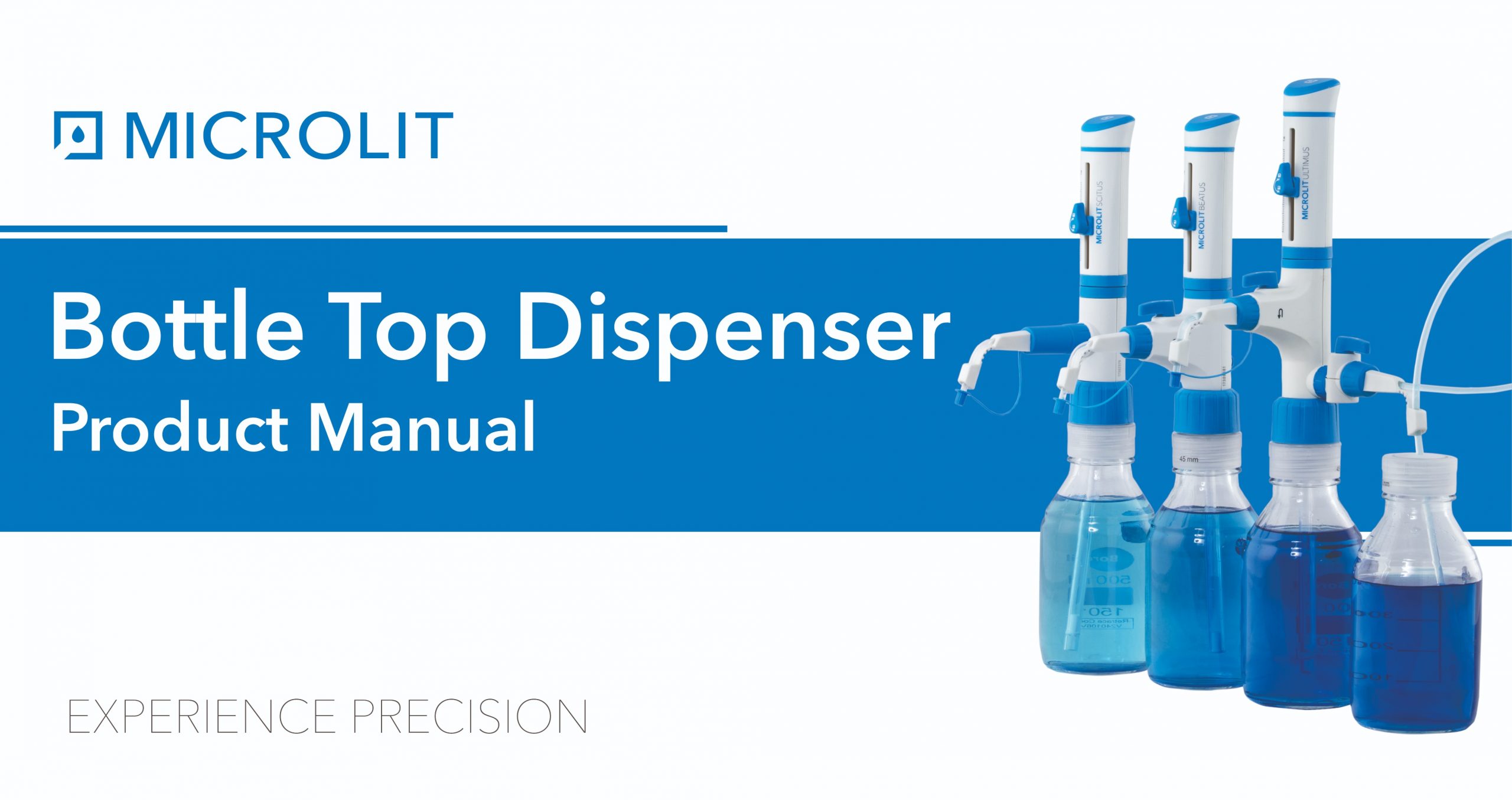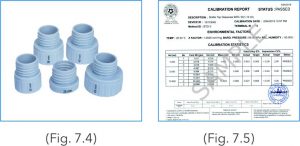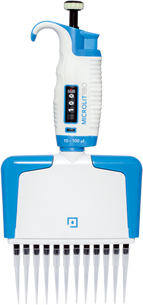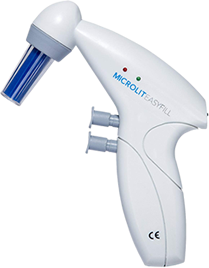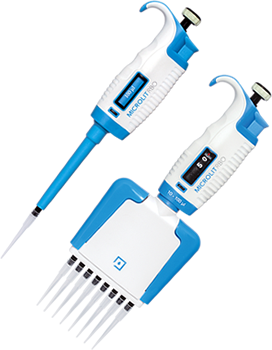1. Intended Use of the Instrument
MICROLIT SCITUS, BEATUS and ULTIMUS are the Bottle Top Dispenser (BTD). It is a high precision liquid handling instrument intended for use in laboratories for dispensing reagents and chemicals that are compatible with it. (Refer to section 6)
2. Safety Instructions
This instrument may sometimes be used for operations involving hazardous materials and equipment. It is beyond the scope of this manual to address all of the potential risks associated with its use in such applications. It is the sole responsibility of the user to consult and establish appropriate safety and health practices and determine the applicability of regulatory limitations,
prior to the usage of this instrument.
NOTE: Please read the following instructions carefully.
- Read and understand this Operation Manual thoroughly before using the instrument.
- Follow general and safety instructions for hazard prevention. E.g., always wear protective clothing, protective gear for the eyes and hands.
- Carefully observe the specifications provided by reagent manufacturers.
- When dispensing inflammable fluids, avoid the built up of static charge. Make sure that you do not dispense into plastic vessels and do not wipe the instrument/equipment with a dry cloth.
- Use the instrument only for dispensing liquids, with strict regard to the defined limitations of use and operating constraints. (Refer to section 3 and 4).
- Observe operating exclusions. When in doubt, contact the manufacturer or supplier.
- Always use the instrument in such a way that neither the user nor any other person is in danger. While dispensing, the discharge tube must always point away from you or any other person. Only dispense into appropriate vessels and avoid splashes.
- Do not press the piston when the discharge tube closure is attached.
- Do not remove the discharge tube while the dispensing cylinder is being filled.
- Reagents can accumulate in the cap of the discharge tube. Thus, clean it regularly.
- Do not carry the mounted instrument by the cylinder sleeve or the valve block. Breakage or loosening of the cylinder may lead to personal injury.
- Do not use the instrument with force. Apply smooth gentle movements to operate the piston. Use only original accessories and spare parts.
- Do not attempt to make any technical alterations. Do not dismantle the instrument any further than is described in the Operation Manual.
- Always check the instrument for visual damage before use.
- If there is any sign of a potential malfunction (e.g. piston difficult to move, stuck valve or leakage), immediately stop dispensing. Consult the ‘Troubleshooting’ section of this Operation Manual and contact the manufacturer if needed. (Refer to section 16)
3. Functions and Limitations of use
MICROLIT BTD is designed to dispense liquids directly from the reservoir bottle. It is calibrated in accordance with the guidelines of the DIN EN ISO 8655 – 5.
When the instrument is correctly used, the dispensed liquid comes into contact with only the following chemically resistant materials: PTFE, FEP and Borosilicate glass.
Physical limits
MICROLIT BTD is designed to be operated under the following physical limits.
- Maintain instrument temperature between +15°C and +40°C (from 59°F to 104°F).
- Maintain reagent vapour pressure up to 600 mbar (maximum). Aspirate slowly above 300 mbar in order to prevent the liquid from boiling.
- Kinematic viscosity upto 500 mm²/s.
(dynamic viscosity [mPas] = kinematic viscosity [mm² /s] x density [g/cm³]) - Use fluids with density upto 2.2 g/cm³.
Operating limitations
- Liquids, which form deposits, may make it difficult for the piston to move or jam it (like crystallizing solutions or concentrated alkaline solutions). If the piston becomes too difficult to move, immediately clean the instrument. (Refer to section 13)
- While dispensing inflammable fluids, avoid the built up of static charge. Make sure that you do not dispense into plastic vessels and do not wipe instruments with a dry cloth.
- MICROLIT SCITUS is designed for general laboratory applications and complies with relevant standards, like DIN EN ISO 8655. Please check the compatibility of the instrument for a specific application (e.g. trace material analysis, food sector etc.). Approvals for specific applications, like production and administration of food, pharmaceuticals and cosmetics are not available.
4. Operating Exclusions
Do not use the instrument with:
- Liquids that attack FEP, PFA and PTFE (e.g. dissolved Sodium Azide*)
- Liquids that attack borosilicate glass (e.g. Hydrofluoric acid)
- Hydrochloric acid > 40% and Nitric acid >70% | Tetrahydrofuran | Trifluoroacetic acid
- Explosive liquids (e.g. Carbon Disulfide)
- Suspensions (e.g. of charcoal) as the solid particles may clog or damage the instrument.
- Liquids that attack PP (cap)
* The permissible concentration of dissolved Sodium Azide is not more than 0.1%.
5. Storage Conditions
Store the instrument and accessories in a clean, cool and dry place. Storage temperature may vary from – 20°C to +50°C (from – 4°F to 122°F)
6. List of Recommended Reagents
Chemicals from A to Z
The following tables enlist the most frequently used reagents. They provide useful information for the safe and efficient use of MICROLIT SCITUS. All the safety precautions and recommendations within this Operation Manual must be followed carefully.
Code explanations:
A = Good resistance
B = Acceptable with limitations
C = Not recommended
1 = Acid vapours (better resistance with lower concentration). Do not leave the instrument on the bottle. Rinse with distilled water after use.
2 = Risk of damage, softening or discoloration of external parts through vapours. Do not leave the instrument on the bottle. Rinse with distilled water after use.
3 = Chemical degradation of glass parts (plunger/barrel)
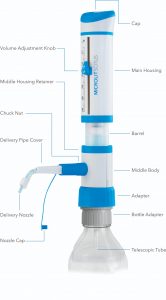 |
|
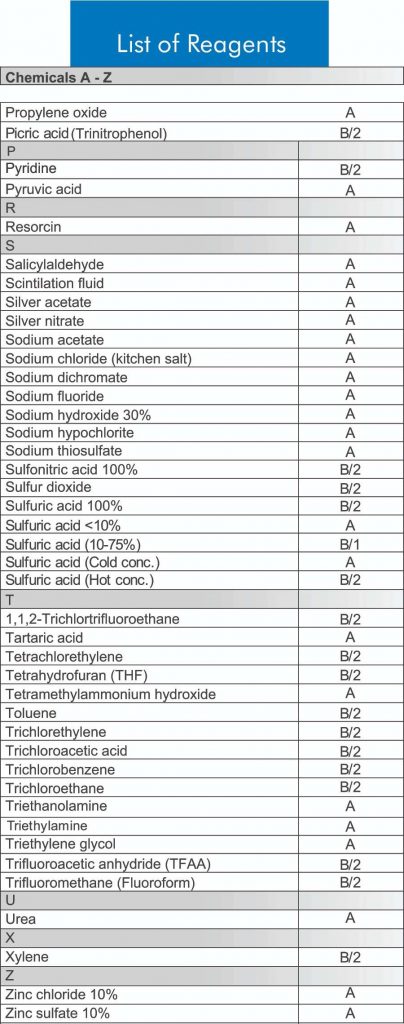 |
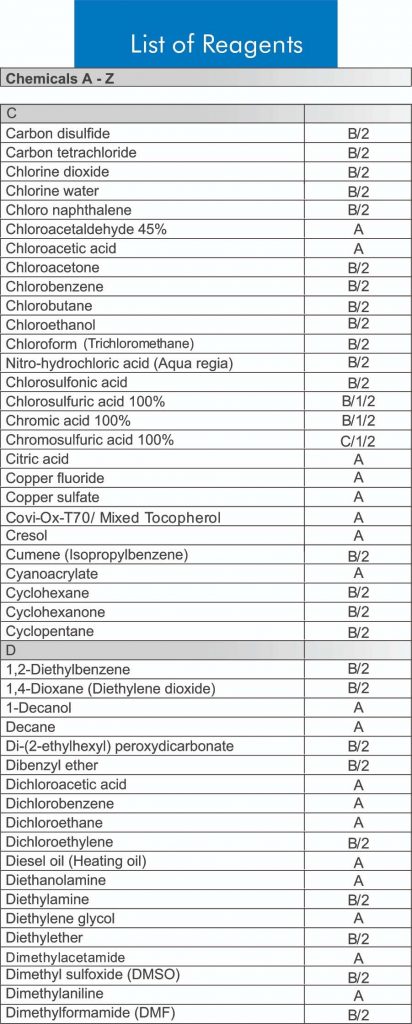 |
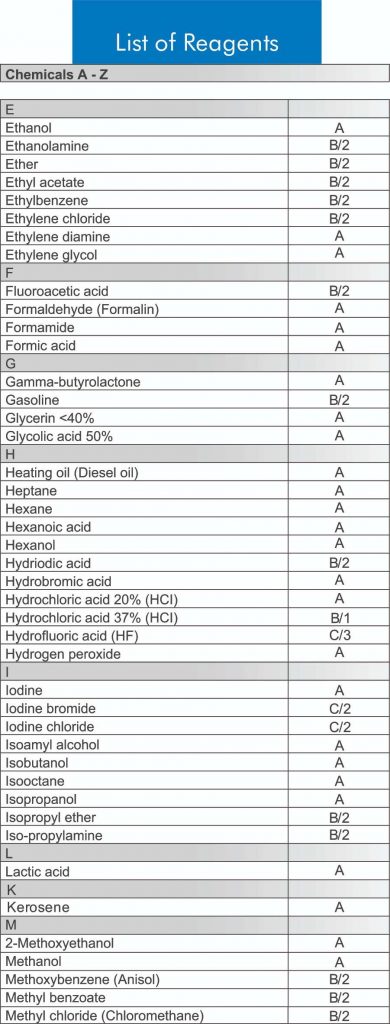 |
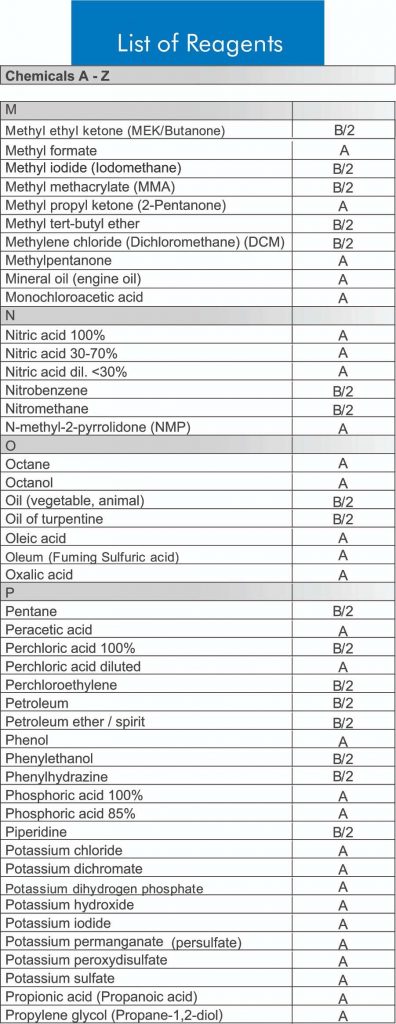 |
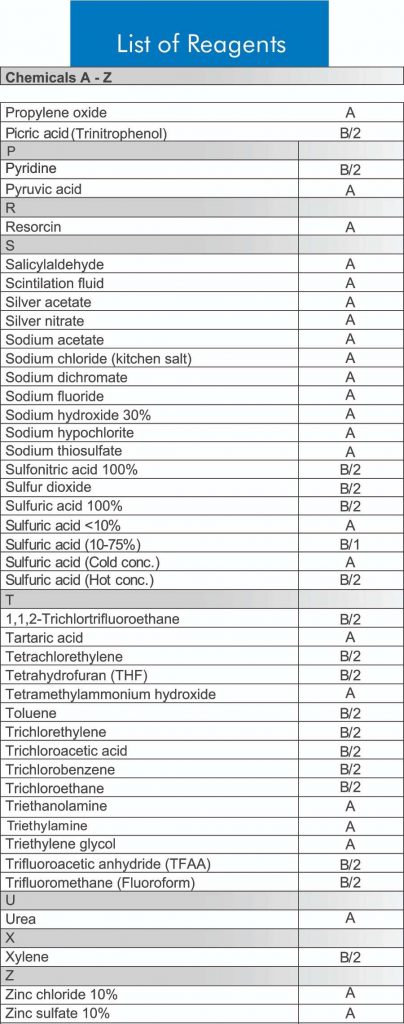 |
|
7. First Steps
First and foremost – check whether everything is there in the package.
Verify that the package includes:
- 1 Bottle Top Dispenser (Refer to Fig. 7.1)
- 1 Telescopic Tube (Refer to Fig. 7.2)
- 1 Calibration Tool (Refer to Fig. 7.3)
- 5 Bottle Adapters (28 mm, 32 mm, 38 mm, 40 mm, 45 mm) (Refer to Fig. 7.4)
- 1 Calibration Certificate (Refer to Fig. 7.5)
- 1 Operation Manual
 |
|
|
8. Setting up
NOTE: Wear protective clothing, protective gear for the eyes and hands. Follow all safety instructions and observe limitations of use and operating constraints. (Refer to sections – 2,3,4)
1. Adjust the length of the telescopic tube to fit your particular reservoir. If you require a longer tube, it is provided on request. (Fig. 8.1)
2. Fix the telescopic tube. The tube’s ends have different diameters. Please select the correct side for your instrument. (Fig. 8.2)
3. Choose the correct adapter for the bottle. The threaded platform base has a 30 mm
screw thread. Five adapters are supplied to suit containers with a 28, 32, 38, 40, 45 mm
and 30 mm (inbuilt adapter) screw neck. (Fig. 8.3)
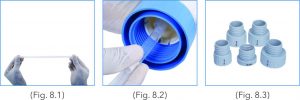 |
4. Fix the adapter. (Fig. 8.4)
5. Mount the instrument. Screw it to the reservoir by applying gentle hand torque applied to the threaded platform base only. In case of removal, apply the same technique to the base, in the opposite direction. (Fig. 8.5)
 |
The instrument is all set up and ready to use.
Do not operate the piston until the entire unit is safely and fully mounted on the reservoir bottle.
Always wear rubber gloves while operating the instrument or handling the bottle, especially when working with hazardous liquids. When mounted to a reagent bottle, always carry the instrument carefully.
Do not press the piston down when the cap is on. Avoid splashing the reagent. The reagent can drip out from the discharge tube and cap. (Fig. 8.6)
9. Priming
1. Place a receiving vessel under the Dispenser’s delivery nozzle.
2. Remove the Nozzle Cap
3. Prime the unit with a few gentle up and down strokes, taking the piston down to its lowest stop position and lifting it up.
4. Repeat until a steady bubble free flow is visible in the barrel.
To avoid splashes while priming, hold the discharge tube against the inner wall of the appropriate receiving vessel. Dispense liquid to prime the discharge tube until it is bubble free. Wipe away any remaining drops from the discharge tube.
Before using the instrument for the first time, ensure that it has been rinsed carefully and discard the first few samples dispensed. Avoid splashing.
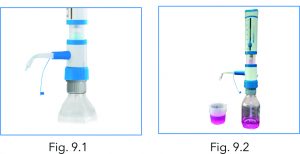 |
10. Volume Setting and Dispensing
Volume Setting
Volume Adjustment Knob is simple and easy to operate. There are two positions of the knob as shown:
Position 1 Locked (Fig. 10.1)
Position 2 Unlocked (Fig. 10.2)
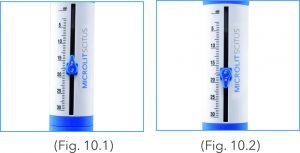 |
To set the volume, follow these simple steps:
- Unlock the Knob by rotating it ANTICLOCKWISE.
- The slider is now loose and can be moved up and down.
- Set your desired volume by aligning the pointer with the scale.
- To lock the set volume, turn the Knob from Position 2 to Position 1 by rotating it CLOCKWISE.
NOTE: Over rotating the knob may lead to breakage.
Dispensing
Wear protective clothing, protective gear for the eyes and hands. Liquid may accumulate in the cap. To avoid splashes, dispense slowly. Follow all safety instructions and observe limitations of use and operating constraints.
1. Remove cap from the discharge tube. (Fig. 10.3)
2. Hold the discharge tube orifice against the inner wall of the appropriate receiving vessel. (Fig. 10.4)
3. Gently lift the piston until the upper end. Press the piston downwards slowly and steadily with minimal force until the lower end. (Fig. 10.5)
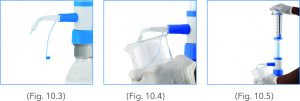 |
4. Wipe off the discharge tube against the inner wall of the receiving vessel.
5. Reattach the cap to the discharge tube. (Fig. 10.6)
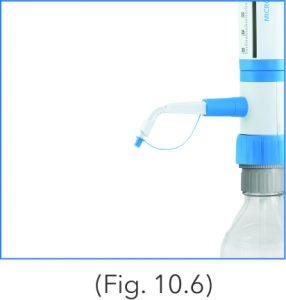 |
11. Error Limits
The error limits (Accuracy and Coefficient of Variation) mentioned below are in accordance with the nominal capacity (or maximum volume) indicated on the instrument. These are obtained by using the instrument with distilled water at equilibrium, ambient temperature of 20 °C or 68°F, while operating the device smoothly and steadily.
The error limits are well within the limits of DIN EN ISO 8655-5.
| Volume Range | Increment | Specifications ISO 8655 | |||
| Accuracy | CV | ||||
| ±% | ±ml | ±% | ±ml | ||
| 0.25 – 2.5 ml | 0.05 ml | 0.06 | 0.015 | 0.2 | 0.005 |
| 0.5 – 5 ml | 0.1 ml | 0.06 | 0.030 | 0.2 | 0.010 |
| 1 – 10 ml | 0.2 ml | 0.06 | 0.060 | 0.2 | 0.020 |
| 2.5 – 30 ml | 0.5 ml | 0.06 | 0.180 | 0.2 | 0.060 |
| 5 – 60 ml | 1.0 ml | 0.06 | 0.360 | 0.2 | 0.120 |
| 10 – 100 ml | 2.0 ml | 0.06 | 0.600 | 0.2 | 0.200 |
12. User Calibration Procedure
MICROLIT SCITUS is laboratory calibrated at its nominal volume. However, due to changes in environmental conditions and the viscosity of the media / fluids which are dispensed, we recommend gravimetric volume testing every 3-12 months.
Gravimetric volume testing, in accordance with DIN EN ISO 8655-6, is performed as follows (for measurement conditions, see section12):
Re-calibration
1. Set the instrument to the nominal volume or any other volume which is most commonly used by you. Follow the common rules for calibration used in statistical quality control (ISO 8655-5).
2. Set the volume and dispense five full volumes of distilled water at 20°C on an electronic balance to establish the actual mean volume of liquid dispensed. If the gravitational average result varies from the volume displayed, you should re-calibrate the instrument.
3. For re-calibration, pull the cap outwards to expose the calibration nut. (Fig. 12.1)
4. Using the calibration tool, turn the calibration nut clockwise to reduce the volume and anticlockwise to increase it. Repeat this procedure till the desired volume is achieved on the electronic balance. (Fig. 12.2)
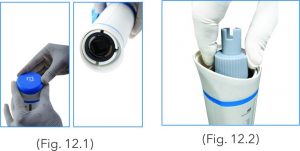 |
13. Maintenance/ Cleaning
MICROLIT SCITUS should be cleaned in the following situations:
- Immediately when the piston is difficult to move
- Before changing the reagent
- Prior to long term storage
- Prior to dismantling the instrument
- Prior to autoclaving
- Prior to changing the valve
- Regularly when using liquids which form deposits (e.g. crystallizing liquids)
- Regularly, when liquids accumulate in the cap.
- All maintenance/cleaning procedures should be carried out while wearing suitable eye protection and protective clothing. When in doubt, consult your safety officer.
- Make sure that the instrument is completely empty.
- Place the instrument into an empty sink together with its reservoir.
- Unscrew the threaded platform base from the reservoir and lift the instrument’s intake tube carefully out of the reservoir, whilst tapping it against the reservoir’s aperture to shake off any droplets from the intake tube.
- Hold the dispensing nozzle over the aperture of the reservoir and apply gentle piston strokes in order to return any contents into the reservoir.
- Empty the instrument completely and flush thoroughly with distilled water.
- If the piston barrel is still not completely clean, you need to disassemble
the instrument. (Refer to section 14)
14. Disassembling and Assembling for Cleaning and Servicing
Procedure to disassemble the piston:
1. Pull the cap outwards to expose the calibration nut. (Fig. 14.1)
2. Unscrew the calibration nut with the help of calibration tool to disassemble the piston and
shaft from the main housing. (Fig. 14.2)
3. After unscrewing, pull out the shaft. (Fig. 14.3)
4. Rinse the piston and shaft with deionized water. (Fig. 14.4)
 |
5. Clean the cylinder with a bottle-brush. If necessary, carefully remove deposits at the edge of the glass cylinder. (Fig. 14.5)
6. Flush all the parts of the instrument with deionized water.
7. Insert the piston completely into the cylinder and then reassemble the instrument using the calibration tool by screwing back the piston. (Fig. 14.6)
8. Snap the cap back to complete the assembly. (Fig. 14.7)
 |
Procedure to disassemble the Delivery Pipe
1. Straighten the delivery nozzle. (Fig. 14.8)
2. Unscrew the chuck nut. (Fig. 14.9)
3. Pull the pipe out of the housing so that the complete delivery pipe is disassembled from the instrument. Do not remove the delivery pipe out of the delivery pipe cover. Delivery pipe housing will look as shown in Fig. 14.10
 |
4. Clean the pipe with deionized water.
Procedure to reassemble the Delivery Pipe
1. First push the delivery pipe into the housing so that it is completely and securely fitted. (Fig. 14.11)
2. Screw the chuck nut to complete the assembly (Fig. 14.12)
3. Adjust the delivery nozzle. (Fig. 14.13)
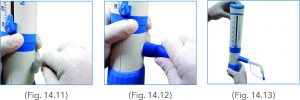 |
15. Autoclaving
MICROLIT SCITUS is fully autoclavable at 121°C (or 250°F) and 1 bar absolute (15 psi) with a holding time of at least 15 minutes.
NOTE – Only the piston needs to be removed for autoclaving the instrument. Piston is also autoclavable.
Disassembling for autoclaving
1. Pull the cap outwards to expose the calibration nut. (Fig. 15.1)
2. Unscrew the calibration nut with the help of calibration tool to disassemble the piston and shaft from the main housing. (Fig. 15.2)
3. After unscrewing, pull out the shaft. (Fig. 15.3)
 |
4. This is the piston-shaft sub-assembly. (Fig. 15.4)
5. Autoclave the two sub-assemblies at 121°C and 15 psi pressure for 10-15 minutes. (Fig. 15.5)
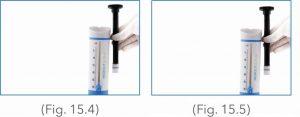 |
6. The volume adjustment knob should always be kept in the ‘unlocked’ position
while autoclaving (Refer fig 10.2).
Cooling
After autoclaving, cool the dispenser at room temperature for at least 2 hours before use.
Re-assembling after autoclaving
1. Insert the piston completely into the cylinder and then reassemble the instrument. Use the calibration tool to screwing the piston. (Fig. 15.6)
2. Snap the cap back to complete the assembly. (Fig. 15.7)
Dispenser is now ready for use. Recalibration is required after autoclaving.
16. Troubleshooting
| Problem | Possible Cause | Solution |
| Piston difficult to move | Formation of crystals or deposition of dirt |
Stop dispensing immediately. Loosen piston in circular motion, but do not disassemble. Follow the cleaning instructions. (Refer to section13) |
| Air bubbles appear in the instrument | Reagent with high vapour pressure has been drawn in too quickly. The instrument has not been primed. Filling tube is loose or damaged. Liquid reservoir is empty. The filling action is too fast. The piston is leaking. The discharge valve is leaking |
Draw the reagent slowly. Prime the instrument (Refer to section 9) Push the filling tube on firmly. If necessary, cut off approx. 1 cm of the tube at the upper end and then re-connect it or replace it. Refill reservoir and prime the unit. Fill and dispense slowly. Clean the piston. Refer to section 13. If problem persists, replace it. Clean by flushing thoroughly with distilled water. (Refer to section 13) |
| Dispensing not possible | Dispensing nozzle is blocked. Discharge valve is stuck. |
Disassemble the dispensing nozzle and flush thoroughly with distilled water. Clean the unit by immersing valve assembly in distilled water. (Refer to section 13) |
| Wrong dispensing volume | The instrument is not calibrated. | Follow user calibration steps. (Refer to section 12) |
| Barrel does not fill with liquid | Inlet tube is not fitted firmly. | Connect inlet tube correctly. (Refer to section 8) |
| Filling not possible | Adjust volume to minimum setting. | Set to the required volume. (Refer to section 10) |
17. Guidelines for Return
Follow these guidelines, before sending the instrument for repair:
- Please clean the instrument carefully.
- On no account should the sent instrument contain any reagent.
- The sent instrument can only be checked and repaired if it has been carefully cleaned and decontaminated, beforehand.
- Forcefully opening the instrument invalidates any warranty claim.
- While packing the instrument for return, please enclose a detailed description of the trouble that has occurred and the reagents that were used with the instrument.
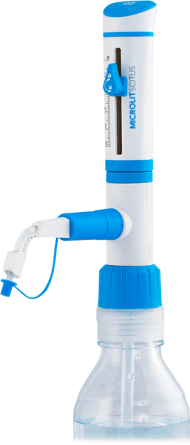





 9981
9981